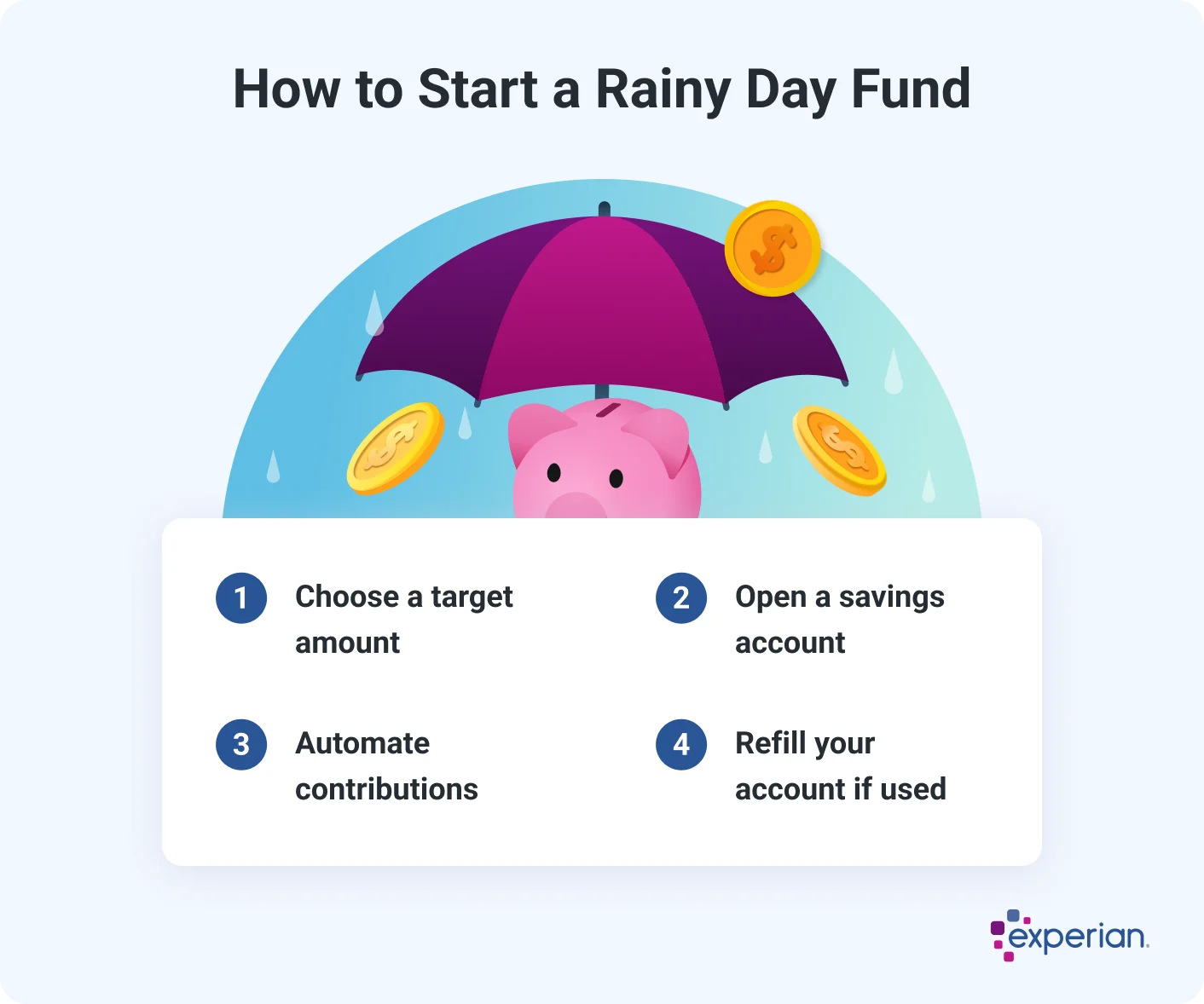What Is a Rainy Day Fund?
Quick Answer
A rainy day fund can help you handle the small, unexpected expenses that are a normal part of life. Separate from your emergency fund, your rainy day fund should hold roughly $500 to $5,000.

A rainy day fund is a financial safety net designed to cover small, unexpected expenses. Though it'd be nice if you could plan for everything, it's impossible to know when your windshield will crack, your dog will get sick or your refrigerator will conk out.
But you don't have to let life's curveballs derail your budget. Learn more about what a rainy day fund is, how it compares to an emergency fund and how to build one.
What Is a Rainy Day Fund?
A rainy day fund is a financial cushion set aside for small yet essential expenses not already factored into your budget. These are costs you don't necessarily include in your budget because they don't have a predictable cadence, but you expect to pay for them at some point.
For example, you never know when you'll need to visit urgent care or call a plumber for a minor repair, but you know these things happen on occasion. That's where a rainy day fund can come in.
How Big Should a Rainy Day Fund Be?
Rainy day funds usually range from around $500 to $5,000, but a comfortable amount for you depends on personal financial factors. That could include your income and typical expenses. The most important thing is to start one, even if that means saving just $50 a month until you reach your desired amount.
Learn more: Average Savings by Age: How Americans Compare
Rainy Day Fund vs. Emergency Fund
A rainy day fund isn't the same as an emergency fund. While a rainy day fund is designed for smaller expenses, an emergency fund is meant to support you during major life changes, events and emergencies.
An emergency fund is ideally much larger than a rainy day fund. Many experts recommend saving three to six months' worth of basic expenses in an emergency fund. The idea is that if you lose a source of income or have a large expense, you'll be able to support yourself until you can get back on your feet. Emergency funds can also be used for larger surprise expenses, such as medical emergencies or major, urgent home repairs.
| Rainy Day Fund | Emergency Fund | |
|---|---|---|
| Purpose | To cover small, unexpected or irregular expenses that don't fit into your budget | To cover major unexpected expenses, or to keep you afloat if you lose your income |
| Recommended savings | $500 to $5,000 | 3 to 6 months' worth of essential expenses |
| Typical use | Small repairs, medical bills, vet bills, replacing broken electronics or small appliances, surprise bills (like parking tickets) | Living expenses while unemployed, major repairs, large medical bills |
| Frequency of use | More often than an emergency account; anytime a smaller essential expense doesn't fit into your budget | Less often than a rainy day fund; only when faced with a genuine emergency |
Learn more: Here's Why You Need an Emergency Fund
Where to Keep Your Rainy Day Fund
Like your emergency fund, you should keep your rainy day fund in an accessible, high-growth account like a high-yield savings account (HYSA). HYSAs earn competitive yields, so your balance will work for you when you're not using it. Plus, HYSA funds are easily accessible when you need them.
You could also keep your rainy day fund in a money market account (MMA). MMAs have similar yields as HYSAs, but they're even more accessible. They often come with checks or a debit card, acting as a hybrid between savings and checking accounts. However, MMAs are typically more likely to have a higher minimum deposit requirement and may come with transaction limits.
Learn more: Check out our roundups of the best high-yield savings accounts and best money market accounts.
Earn Money Faster
Compare high-yield savings accounts
Find a high-yield savings account with today’s APY. Compare current APY and offers to find the best savings account for you.
How to Start a Rainy Day Fund
If you don't yet have a rainy day fund to cover smaller unplanned expenses, here's how you can start one:
- Choose a target amount. Look back at your finances over the past year. How much did you spend on smaller, unplanned expenses? Tally up your spending on things like vet visits, home and car repairs or doctor appointments—anything that wasn't specifically planned for in your budget—and aim to save that amount. When in doubt, a target between $500 and $5,000 is a good starting point.
- Open an account. It's best to keep your rainy day fund separate from your emergency fund and other savings goals so there's no question about what each dollar is for. To do so, open a new HYSA or MMA for your rainy day fund. Alternatively, if your current savings account comes with subaccounts, you can designate a new subaccount for your rainy day fund.
- Automate contributions. Make regular contributions into your rainy day fund until you hit your target amount. For a fool-proof savings strategy, set up automated transfers from your checking account to your savings account. Start with whatever amount is manageable, increasing your monthly contribution when possible. Use Experian's savings calculator to see how quickly your rainy day fund can grow over time.
- Refill your account as needed. As you spend down your rainy day fund, it's important to replenish it. When the balance drops below your target amount, restart those monthly contributions. Another tactic is to refill your fund in one fell swoop with a larger windfall, like a bonus.
Learn more: What Is a Savings Plan?

The Bottom Line
Aim to save between $500 and $5,000 in a rainy day fund in addition to your emergency fund. While your emergency fund is for those major life events, like losing a job or getting a divorce, your rainy day fund should cover small, unplanned expenses, like fixing your car or repairing an appliance.
A rainy day fund can be the difference between a small inconvenience and a financial catastrophe. Even though your rainy day fund is meant for small expenses, it can prevent you from using high-interest debt that can quickly get out of hand. Having a solid cushion set aside for rainy days can give you confidence that life's little surprises won't derail your financial plans.
Want to lower your monthly bills?
We’ll negotiate bills for you and cancel unwanted subscriptions.
Get started